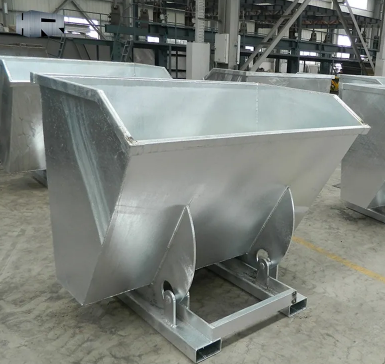
Self-tipping bins are a type of waste container that is designed to automatically tip or empty its contents without the need for manual intervention. These bins are commonly used in industrial, commercial, and municipal settings to streamline waste collection processes and improve overall efficiency.
There are several ways in which self-tipping bins can improve efficiency in waste management operations:
1. **Labor Savings**: One of the biggest benefits of self-tipping bins is the reduction in labor costs associated with waste collection. With traditional bins, workers have to manually empty each container, which can be time-consuming and physically demanding. Self-tipping bins eliminate the need for manual lifting and emptying, allowing workers to focus on other tasks and increasing overall productivity.
2. **Faster Collection Times**: Self-tipping bins can significantly speed up the waste collection process. By automating the tipping and emptying of bins, collection trucks can move more quickly from one location to the next, reducing overall collection times and improving the efficiency of the waste management operation.
3. **Reduced Risk of Injury**: Manual lifting and emptying of heavy bins can pose a risk of injury to workers, especially in settings where large amounts of waste are generated. Self-tipping bins help to reduce the risk of musculoskeletal injuries and other workplace accidents by automating the process of emptying bins.
4. **Increased Capacity**: Self-tipping bins typically have larger capacities than traditional bins, allowing them to hold more waste before needing to be emptied. This can help to reduce the frequency of collection trips, saving time and resources in the long run.
5. **Improved Hygiene**: Self-tipping bins are often designed with features to improve hygiene and reduce the risk of contamination. For example, some bins have self-cleaning mechanisms or sealed lids to prevent odors and pests. By maintaining a clean and sanitary environment, self-tipping bins can help to protect the health and safety of workers and the general public.
6. **Enhanced Data Collection**: Some self-tipping bins come equipped with sensors or RFID technology that can track fill levels, monitor usage patterns, and provide valuable data on waste generation. This data can be used to optimize collection routes, schedule maintenance, and improve overall efficiency in waste management operations.
7. **Environmental Benefits**: By promoting more efficient waste collection and disposal practices, self-tipping bins can help to reduce the environmental impact of waste generation. For example, fewer collection trips mean lower fuel consumption and emissions, while larger bin capacities can help to reduce the amount of landfill space needed.
In conclusion, self-tipping bins offer a range of benefits that can improve efficiency in waste management operations. By automating the process of emptying bins, reducing labor costs, speeding up collection times, and promoting a cleaner and safer working environment, self-tipping bins are an effective solution for managing waste more effectively and sustainably.




Comentario
(0)